
It’s laborious to beat the colourful colours and leap-off-the-screen brightness that the perfect QLED TVs ship. Then once more, it’s equally tough to duplicate the insane black ranges, ultra-rich colours, and unbelievable distinction of an OLED set. However what would occur if TV producers determined to mix each of those superb image applied sciences? Such a leap of religion has already been taken, pals, and the result’s the QD-OLED.
Launched a few years again, QD-OLEDs can be found from manufacturers like Samsung and Sony, in addition to Alienware (in the event you’re looking for a QLED laptop monitor). On paper, this show tech combines the perfect components of each QLED and OLED fashions, which implies these units must be able to getting good and vivid, whereas nonetheless delivering unbelievable distinction ranges and a large coloration gamut. However does this sensible amalgamation really ship? Let’s take a more in-depth have a look at the world of QD-OLEDs to seek out out.
What’s QD-OLED?
Merely put, QD-OLED is a hybrid show know-how that takes the already very spectacular qualities of OLED TV and improves its brightness and coloration by the usage of quantum dots.
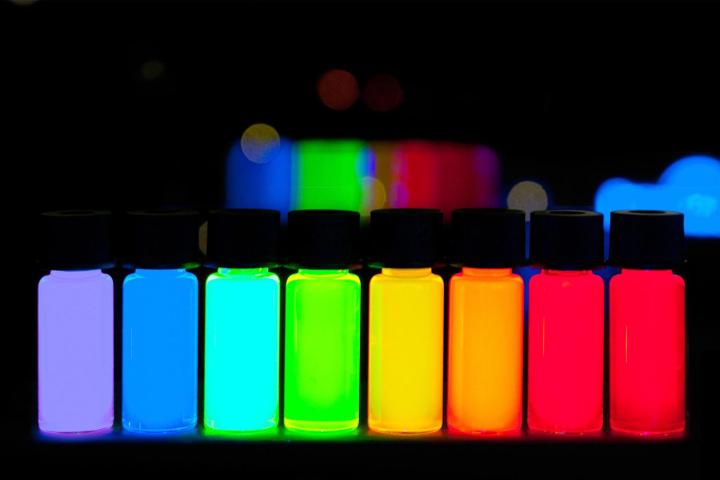
The result’s a TV that displays the beautiful ranges of distinction and ideal blacks of OLED whereas delivering brightness ranges that exceed something we’ve seen from OLED up to now.
This “better of each worlds,” profit was largely theoretical till we received an opportunity to see it for ourselves at CES 2022. These impressions survived even as soon as we introduced the primary two QD-OLED TVs in for testing: first with the Sony A95K, after which once more with the Samsung S95B. Each TVs earned a uncommon 10/10 score from our TV guru, Caleb Denison. And now every of those QD-OLEDs has jumped forward to the following era, with Samsung delivering the S95C mannequin for 2023, and Sony bringing us the chart-topping A95L. Again in 2022, we additionally had the nice fortune of reviewing one in all Alienware’s terrific QD-OLED displays.
Image enhancements apart, it’s additionally potential that over time, QD-OLED TVs could show inexpensive to purchase than equally sized OLED TVs. We’ll focus on this in additional element later. Since QD-OLED TVs are primarily an evolution of OLED, it’s anticipated that among the intelligent issues we’ve seen LG do with its OLED panels, like clear shows and rollable shows, could possibly be potential with QD-OLED fashions, too.
How does QD-OLED work?
To grasp the inside workings of QD-OLED, we have to shortly clarify the variations between QLED and OLED.
QLED TV
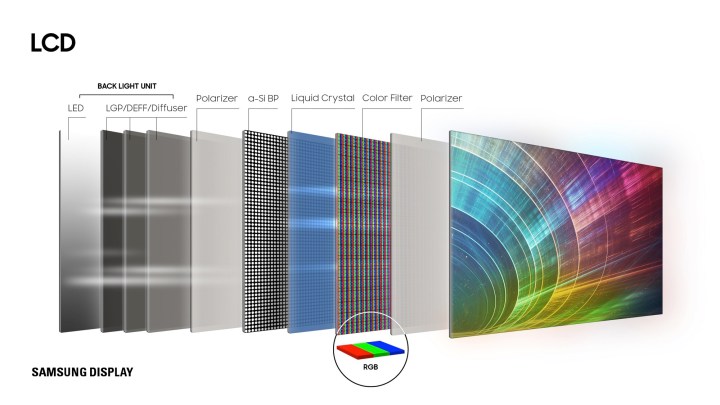
QLED TV makes use of 4 predominant parts to supply its footage: An LED backlight, a layer of quantum dots, an LCD matrix, and a coloration filter.
The LED backlight produces all the brightness you see — and fashionable LED backlights can produce rather a lot of brightness, way over OLED mild sources. However reaching that brightness whereas sustaining a full-spectrum white, is tough.
The answer: Begin with a extremely vivid blue LED mild supply, then use pink and inexperienced quantum dots to stability the blue right into a full spectrum of white. As a result of quantum dots might be tuned to emit particular colours and, amazingly, can do that at a virtually 100% effectivity degree, QLED TVs get a much-needed enchancment to their coloration accuracy with out sacrificing any brightness or needing to make use of extra power.
From there, the purified white mild passes by the LCD matrix (which is answerable for the photographs you see, and the way vivid or darkish areas of the display are) and, lastly, by the colour filter, which converts the white mild into the correct quantities of pink, inexperienced, and blue in order that we see true coloration pictures.

It’s a very good system that produces vivid and really colourful pictures. It’s additionally fairly inexpensive to supply as a result of, apart from the quantum dots, all the parts have been round for many years, and at the moment are “low-cost” to make.
But it surely has drawbacks, too. Irrespective of how laborious the LCD matrix tries, it could’t block 100% of the sunshine from coming by in darkish scenes, so that you by no means get that excellent, inky black that you just see on an OLED TV. The LCD matrix additionally creates issues for off-angle viewing as a result of it tends to “tunnel” mild straight outward from the display.
QLED additionally has to make use of extra power to create the brightness you see as a result of the mixture of the LCD matrix and the colour filter diminishes the sunshine the LED backlight generates. This makes QLED TVs much less power environment friendly than OLED TVs.
Lastly, and this will solely matter to decor-oriented TV consumers, all of these parts add as much as a thicker total TV panel.
OLED TV
OLED TV makes use of an OLED mild supply and a coloration filter to supply its picture.
That sounds remarkably easy in comparison with QLED TV, and it’s. Due to the emissive nature of the essential ingredient of OLED TV — the OLED pixel — this one ingredient can deal with brightness and picture creation, primarily fulfilling the roles of each the LED backlight and the LCD matrix in QLED TV.
With out an LCD matrix, viewing angles with OLED TVs are as near-perfect as we’ve ever seen. You’ll be able to sit wherever you want and nonetheless see the identical ranges of brightness, distinction, and coloration.
And as we’ve already hinted, as a result of OLED pixels might be shut off fully when a picture requires excellent blackness, that’s precisely what you get: No mild being emitted in any respect.
However OLED TV isn’t excellent both. You’ll be able to solely derive a lot brightness from an OLED pixel. It’s glorious in low-light situations, but it surely merely can’t compete with QLED’s devoted LED backlight in brighter environments. When you’ve ever checked out a QLED and OLED TV aspect by aspect in a brightly lit Costco warehouse and located the QLED TV extra interesting, it’s most likely as a result of its superior brightness.

OLED TV brightness is decrease than QLED for 2 predominant causes. First, and most significantly, every OLED pixel creates its personal mild. However the extra energy you drive by an OLED pixel, the extra you shorten its lifespan. So OLED TVs might most likely get brighter than they do in the present day, however few consumers could be OK with a TV that solely lasted half as lengthy. The LEDs utilized in a QLED TV’s backlight are far much less prone to this type of getting older and may proceed to supply a lot of mild for a very long time.
Second, irrespective of how a lot mild an OLED pixel can create, a few of that mild can be absorbed by the colour filter.
OLED panels are additionally prone to one thing referred to as burn-in. When you show the identical form of content material on an OLED TV for tons of consecutive hours — say a decrease information banner on a information channel or a management panel in a online game — it could trigger these pixels to age at a sooner fee than the pixels which are always displaying totally different pictures.
The residual “shadow” of that static content material known as burn-in, and as soon as it occurs, it’s normally everlasting.
Lastly, as a result of the large-format OLED panel market is successfully a monopoly, with only one firm — LG Show — manufacturing and promoting them to corporations like LG, Sony, Philips, and Vizio, it should stay dearer than QLED for a while to return.
QD-OLED: Busting the brightness barrier
So the query that faces the TV world is, how are you going to maintain on to all of OLED’s many advantages and enhance on its weaknesses?
The answer is QD-OLED, additionally referred to by some corporations as “QD Show.”
Quantum Dot OLED considerably will increase the general brightness of OLED — and even improves its already excellent coloration — by optimizing how a lot mild a single OLED pixel can emit and eliminating the colour filter.
Right here’s the way it works.
Why begin with white?
In the mean time, OLED TVs create their mild and coloration place to begin with white mild. They do that by combining blue and yellow OLED materials to create a mix that comes very near pure white. Why do that as a substitute of utilizing pink, inexperienced, and blue OLED materials? The reply has to do with the complexities of producing OLED panels on the 50-inch to 88-inch sizes of in the present day’s TVs whereas retaining prices as little as potential.
To provide you a way of simply how costly a real RGB OLED panel is, Sony used to make a 4K, 55-inch monitor for the printed and movie industries that used this know-how. It price almost $28,000, though the mannequin has since been discontinued, and it doesn’t seem like Sony has any plans of introducing a next-gen successor anytime quickly.
However if you begin with white mild, you want a solution to separate the person pink, inexperienced, and blue parts of the spectrum. A coloration filter does this admirably, however coloration filters, as we talked about above, cut back brightness.
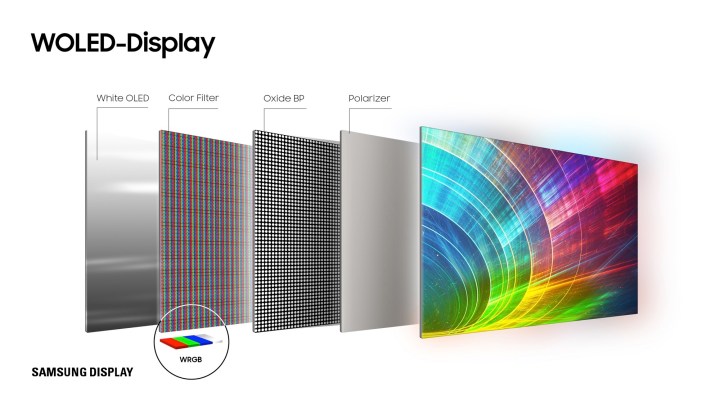
LG’s approach for regaining among the brightness misplaced to the colour filter entails the usage of a white subpixel that bypasses the colour filter.
While you’re watching commonplace dynamic vary (SDR) content material, the usage of that white subpixel is average. OLED TVs can simply get vivid sufficient to satisfy the complete specification for SDR with out relying closely on the brightness of the white subpixel.
“Shows of all kinds that use this structure are in a position to obtain coloration accuracy at comparatively decrease luminance,” stated Jeff Yurek, director of selling and investor relations at Nanosys, an organization that develops quantum dot know-how. However HDR materials is a bit trickier.
When viewing HDR content material, the panels turbocharge these white subpixels to ship HDR’s larger brightness. However there’s a restrict to how laborious you possibly can drive these white subpixels. Push them too far and never solely do you cut back the panel’s life, however that further brightness may wash out the colour of the opposite subpixels, one thing that’s particularly noticeable when displaying small options like textual content, which may usually look much less crisp.
Again to blue
To cope with the technical hurdles of OLED brightness, QD-OLED TVs take a web page out of QLED TV’s handbook. Utilizing the identical precept that lets a QLED TV flip a blue backlight right into a pure white mild utilizing pink and inexperienced quantum dots, a QD-OLED panel makes use of simply blue OLED materials as the premise of every pixel.
That blue OLED pixel is then divided into three subpixels: A blue subpixel, which is the unique blue OLED materials, left unchanged; a pink subpixel that layers red-tuned quantum dots over blue OLED; and a inexperienced subpixel that layers green-tuned quantum dots over blue OLED.
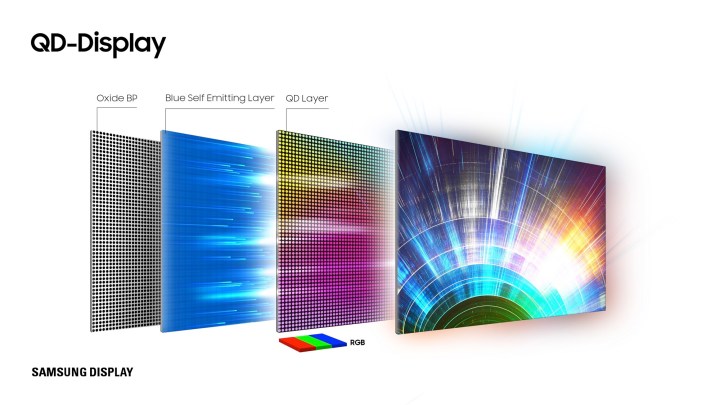
Since quantum dots are so energy-efficient, just about no brightness is misplaced in these two coloration transformations. The result’s a real RGB OLED show with out the price and complexity of a discrete RGB OLED place to begin, the brightness tax of a coloration filter, or the necessity for a color-sapping white subpixel.
“What’s so thrilling about QD-OLED shows,” Yurek stated, “is that they don’t require a white subpixel to achieve peak luminance. QD-OLED will be capable to specific the complete coloration quantity from close to black all the best way as much as full-peak luminance with out compromise.”
Sudden developments
When QD-OLEDs first hit the market in 2022, you might solely discover them at as much as 65 inches. Now that we’re effectively into the second wave of this TV tech although, the max measurement of those units has elevated. Samsung’s S90C and S95C fashions can be found in 77-inch display sizes, as is Sony’s A95L QD-OLED.
Samsung really makes an 83-inch OLED TV too, however in a stunning flip of occasions, that is really not a real QD-OLED. Bear in mind our above dialogue about how OLED panels work, and the way these screens are primarily monopolized by LG Show? Effectively after years of ragging on its competitors, Samsung launched its 83-inch S90C mannequin this previous summer time, and get this: it’s not a QD-OLED. It’s technically a conventional WOLED display, made by none aside from LG Show.
And to make issues further complicated, Samsung (and Sony, to an extent) are usually not precisely forthcoming in relation to utilizing QD-OLED branding for its QD-OLED TVs. For instance, the S90C and S95C collection are listed on Amazon and Finest Purchase’s web site as common OLED TVs. It’s not till you begin digging into full specs and opinions that you just’ll uncover QD-OLED terminology.
That is all to say that whereas QD-OLED continues to be evolving and bettering, it’s a good suggestion to be further astute if you see net and print adverts for bigger fashions. In spite of everything, you don’t wish to spend the large bucks on an enormous display, considering it’s a QD-OLED, solely to seek out out later that you just’ve bought a conventional OLED set.
QD-OLED: extra inexpensive?
It might take a number of years, but it surely’s potential that QD-OLED TVs will find yourself costing lower than OLED TVs to make. Eliminating the colour filter is a good way to cut back supplies and manufacturing complexity, which ought to imply a smaller outlay of money.
And since QD-OLED will theoretically be brighter than OLED with out the usage of extra electrical energy, it is perhaps potential to create QD-OLEDs which have the identical brightness as OLEDs whereas utilizing much less power. Decrease power use brings down the price of lots of the parts that need to be engineered to deal with larger power masses.
This all assumes that the investments wanted to make QD-OLED manufacturing a actuality can be paid off shortly, however that’s removed from sure at this level.
Having your (OLED) cake and consuming it, too
Blue OLED materials — the sunshine supply of QD-OLED shows — is a notoriously difficult substance to work with.
Very similar to different OLED supplies, there’s a three-way trade-off between lifespan, brightness, and effectivity. Typically talking, any time you prioritize one in all these attributes, the opposite two endure. Drive an OLED pixel laborious sufficient to supply the brightness you need and also you not solely diminish its life expectancy but in addition its effectivity.
However QD-OLED shows could show to be the exception to this rule. By utilizing three layers of blue OLED materials per pixel, every layer can share the brightness burden.
“The quantity of energy wanted from the blue OLED pixel within the QD-OLED to supply a given quantity of front-of-screen brightness can be much less,” stated Jason Hartlove, CEO and president of Nanosys.
Who makes QD-OLED TVs?
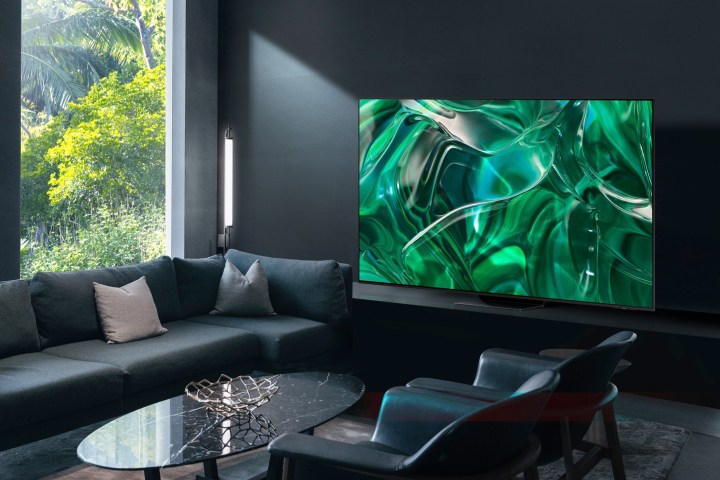
In the mean time, Samsung Show — a division inside Samsung that develops show applied sciences however doesn’t promote ultimate merchandise like TVs or displays — is the one firm manufacturing QD-OLED panels. It sells these panels to corporations like Sony, Dell’s Alienware division, and Samsung Electronics (the Samsung division that makes and sells TVs). We anticipate different corporations will be part of the ranks of Samsung Show’s QD-OLED prospects now that we’re a few years into this TV tech.
We’re assured that there’ll ultimately be many corporations promoting QD-OLED TVs, however for now, it appears to be like like Sony and Samsung are alone on this new area.
When will QD-OLED TVs be in the stores?
You should purchase QD-OLED TVs proper now, from Samsung and Sony, however as we talked about up above, it’s possible you’ll not notice it due to the best way every firm names its merchandise.
As an example, Sony’s present QD-OLED known as the Sony Bravia XR A95L 4K HDR OLED TV on Finest Purchase’s web site, but it’s clearly labeled as a QD-OLED on Amazon (go determine). Over on Samsung’s aspect of the sphere, each the S90C and S95C QD-OLEDs are labeled as straight-up OLEDs by Amazon and Finest Purchase. Cease perplexing us, guys! These acronyms are complicated sufficient.
You should purchase the Samsung S90C and S95C fashions in 55, 65, and 77-inch sizes. As for Sony, the XR A95L can also be accessible in 55, 65, and 77-inch sizes.
How a lot do they price?
Samsung’s QD-OLED TVs price significantly lower than Sony’s, although as Senior Editor, Caleb Denison, factors out, most individuals wouldn’t be capable to respect the refined enhancements that Sony provides. This makes Sony’s value premium tough to rationalize.
The Samsung OLED 4K Good TV S95C begins at $2,200 for the 55-inch mannequin, whereas the 65-inch model prices $3,300. These are full MSRP costs although, and we’ve seen each the S90C and S95C lineup receiving some huge reductions. In truth, because it stands, you should buy the 65-inch S95C on Amazon for $2,400, which is $900 off its retail value. As for the 77-inch S95C, full retail is $4,000, however we’ve seen the TV marked right down to $3,500 at instances.
When you’d reasonably go for the Samsung S90C, pricing begins at $1,900 for the 55-inch mannequin, which we’ve already seen as little as $1,300. The 65-inch model retails for $2,000, with costs as little as $1,600, and the 77-inch measurement retails for $3,600, however has gone as little as $2,500!
For its half, Sony sells the 55-inch Bravia XR A95L for $2,800, however we’ve seen it on sale for as little as $2,500. There’s additionally the 65-inch for $3,500, which we’ve seen as little as $3,300. Not solely are these common costs a lot larger than Samsung’s, however the reductions we’ve seen are additionally much less thrilling — solely about $300.
Is QD-OLED the final phrase in TV know-how?
Nope! Nothing halts the progress of know-how, and the businesses that manufacture quantum dots have their sights set firmly on the eventual domination of the TV panorama.
QDEL sounds just like the holy grail of TV tech, doesn’t it?
Bear in mind after we stated that quantum dots use mild power at virtually 100% effectivity to supply their very own mild? Effectively, it seems that quantum dots aren’t choosy about their weight loss plan. They will also be energized utilizing electrical energy for what’s referred to as quantum dot electroluminescence, or QDEL. In keeping with our pals at FlatPanels HD, at CES 2023, sure fortunate events got a closed-door have a look at a six-inch QDEL-powered Nanosys machine.
Proper now, Nanosys is referring to this revolutionary quantum dot prototype as a “NanoLED” show, and these electrically charged dots ought to lead to a lot thinner, brighter, and much more energy-efficient TVs down the road.
MicroLED TVs are additionally turning into potent, if dear, alternate options for the house show market. Their modular design implies that their key power is having the ability to scale from as small as 76 inches to effectively over 16 ft, however they’re additionally extremely vivid whereas possessing black ranges and coloration accuracy to match QD-OLED TVs. However for now, they continue to be bulkier, are dearer, and pack decrease resolutions per inch than every other show know-how.
Samsung presently makes a 110-inch, 4K microLED TV, but it surely doesn’t promote the product on to consumers or by retail shops like Finest Purchase. As an alternative, it’s important to contact a Samsung-licensed AV installer. And if it’s important to ask how a lot it prices, effectively … you understand how that one goes.
Nonetheless, identical to QD-OLED, OLED, and plasma, it’s anticipated that microLED will quickly turn into extra inexpensive, extra adaptable, and accessible in sizes that the typical purchaser may need.
Editors’ Suggestions
Supply Hyperlink : https://kalender.uk/


